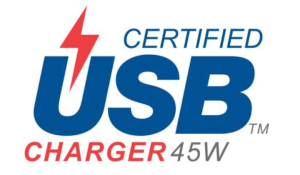-
Power bricks like this one for Intel's Core M Compute Stick are nice, but at a glance it can be hard to know how or whether it will work with other Type-C devices.Andrew Cunningham
-
The new charger logo and compliance program.USB-IF
-
The new logo and some basic selling points for certified adapters.USB-IF
USB Type-C remains a versatile port with a ton of potential, but the fact that different Type-C ports have different capabilities is still a sticking point. Especially in laptops and desktops, it’s hard to tell whether a port will charge the laptop or drive a monitor or just do plain old data. For the USB Implementers Forum, a body that can strongly recommend ways for USB licensees to market and label their products but can’t actually mandate anything, defining new standards and logos are its best weapon against consumer confusion.
To that end, the USB-IF is introducing a new “Certified USB Charger Compliance and Logo Program,” a more consumer-friendly face for Type-C chargers compatible with the USB Power Delivery spec. Certified chargers will “resemble a traditional power brick or wall wart” and “will be interoperable with compatible USB Type-C devices,” and it’s one more incremental step toward universal chargers that actually work with every gadget you’ve got to carry around.

In return for meeting the requirements, manufacturers will be able to (but are not required to) slap a USB logo on the chargers that denotes that it has been certified by the USB-IF and how much power it can supply. The USB Power Delivery spec can supply up to 100W of power, but the USB-IF believes that 15W, 27W, 45W, and 60W will be the most common. And there’s nothing stopping licensees from using their power adapters to supply some additional functionality, like Intel’s Compute Stick power brick that doubles as a USB hub.
The program may also make some phone and PC makers more comfortable with letting any certified Type-C charger provide power to their devices. Currently, a handful of PCs will only let you charge them if you use the Type-C chargers they shipped with—the logo program and the Type-C Authentication spec should help counteract this. But as with any logo or spec, they’re only useful if people use them, and the only way to know whether that happens is to wait and see.
Listing image by Andrew Cunningham
reader comments
60